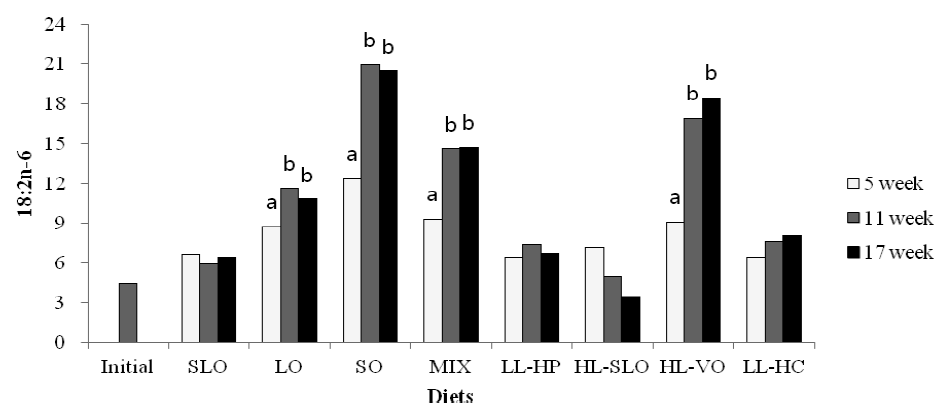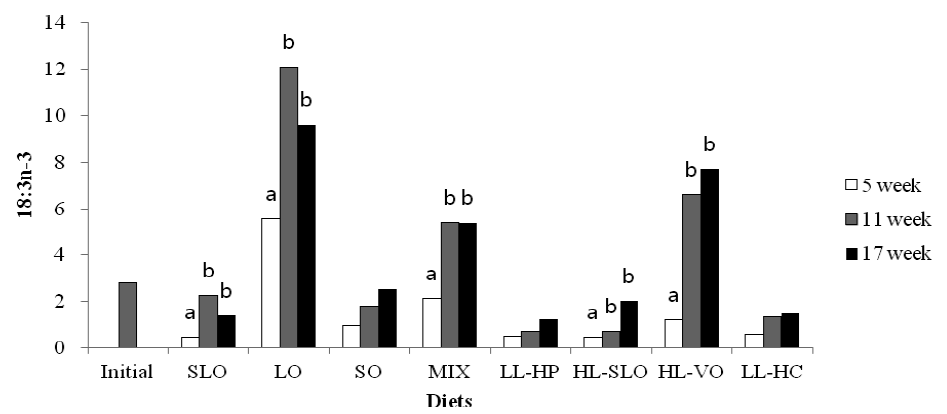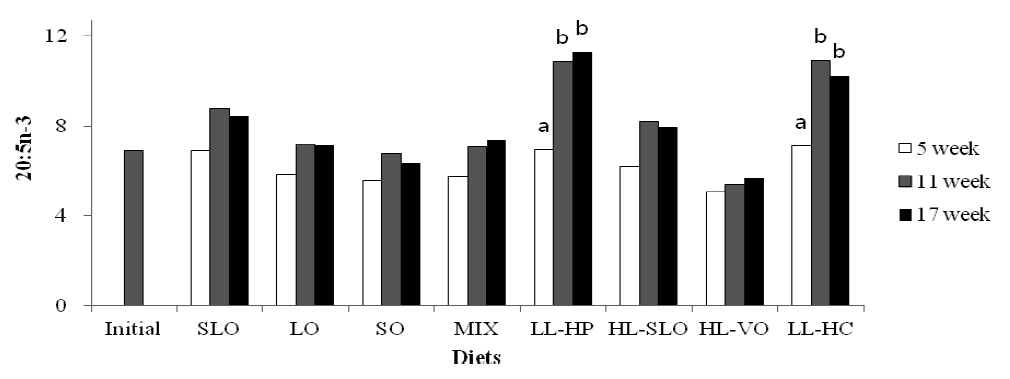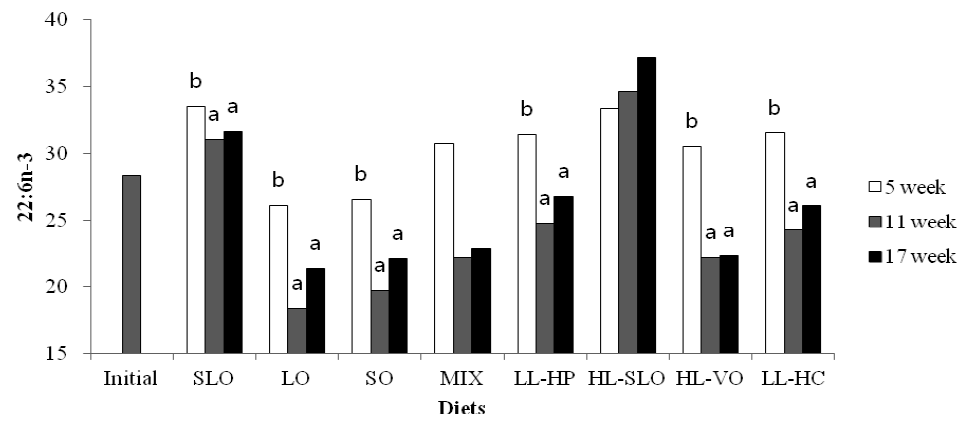Abimorad EG, Carneiro DJ. 2007. Digestibility and performance of pacu (
Piaractus mesopotamicus) juveniles-fed diets containing different protein, lipid and carbohydrate levels. Aquac Nutr 13:1ŌĆō9.

AOAC (Association of Official Analytical Chemists). 1995. Official methods of analysis. 16th ednAssociation of Official Analytical Chemists; Arlington, Virginia, USA:
Bell JG, McEvoy J, Tocher DR, McGhee F, Campbell PJ, Sargent JP. 2001. Replacement of fish oil with rapeseed oil in diets of Atlantic salmon (
Salmo salar) affects tissue lipid composition and hepatocyte fatty acid metabolism. J Nutr 131:1535ŌĆō1543.


Bell JG, Henderson RJ, Tocher DR, Sargent JR. 2004. Replacement of dietary fish oil with increasing levels of linseed oil: modification of flesh fatty acid compositions in Atlantic salmon (
Salmo salar) using a fish oil finishing diet. Lipids 39:223ŌĆō232.


Caballero MJ, Obach A, Roselund G, Montero D, Gisvold M, Izquierdo MS. 2002. Impact of different dietary lipid sources on growth, lipid digestibility, tissue fatty acid composition and histology of rainbow trout,
Oncorhynchus mykiss. Aquaculture 214:253ŌĆō271.

Dannevig BH, Norum KR. 1982. Cholesterol esterification and lipids in blood plasma of the char (
Salmo alpinus L.) during sexual maturation. Comp Biochem Physiol B 73:771ŌĆō777.


Deng J, Mai K, Ai Q, Zhang W, Wang X, Xu W, Liufu Z. 2006. Effects of replacing fish meal with soy protein concentrate on feed intake and growth of juvenile Japanese flounder,
Paralichthys olivaceus. Aquaculture 258:503ŌĆō513.

Duncan DB. 1955. Multiple-range and multiple F tests. Biometrics 11:1ŌĆō42.

Es├®vez A, Delgado A, Hortelano P, Alejandre M. 1996. Characterization of mevalonate metabolism in the sea bass,
Dicentrarchus labrax L, liver. Fish Physiol Biochem 15:205ŌĆō211.


Francis DS, Turchini GM, Jones PL, De Silva SS. 2007. Effects of fish oil substitution with a mix blend vegetable oil on nutrient digestibility in Murray cod,
Maccullochella peelii peelii. Aquaculture 269:447ŌĆō455.

Folch J, Lees M, Sloane-Stanley GH. 1957. A simple method for the isolation and purification of total lipids from animal tissues. J Biol Chem 226:497ŌĆō509.

Fountoulaki E, Vasilaki A, Hurtado R, Grigorakis K, Karacostas I, Nengas I, Rigos G, Kotzamanis Y, Venou B, Alexis MN. 2009. Fish oil substitution by vegetables oils in commercial diets for gilthead sea bream (
Sparus aurata L.); effects on growth performance, flesh quality, and fillet fatty acid profile; recovery of fatty acid profiles by a fish oil finishing diet under fluctuating water temperatures. Aquaculture 289:317ŌĆō326.

Gilman CI, Leusch FDL, Breckenridge WC, MacLathcy DL. 2003. Effects of a phytosterol mixture on male fish plasma lipoprotein fractions and testis P450scc activity. Gen Comp Endocrinol 130:172ŌĆō184.


Glencross BD, Hawkins WE, Curnow JG. 2003. Evaluation of canola oils as alternative lipid resources in diets for juvenile red seabream,
Pagrus auratus. Aquac Nutr 9:305ŌĆō315.

Hillestad M, Johnsen FT. 1994. High-energy/low-protein diets for Atlantic salmon: effects on growth, nutrient retention and slaughter quality. Aquaculture 124:109ŌĆō116.

Herzberg GR, Craig SRT, Levy R. 1996. Eicosapentaenoic acid is oxidized more rapidly than docosahexanenoic acid by muscle and liver. Nutr Res 16:639ŌĆō644.

Izquierdo MS, Montero D, Robaina L, Caballero MJ, Rosenlund G, Gines R. 2005. Alterations in fillet fatty acid profile and flesh quality in gilthead seabream (
Sparus aurata) fed vegetable oils for a long term period. Recovery of fatty acid profiles by fish oil feeding. Aquaculture 250:431ŌĆō444.

Kaushik SJ, Cowey CB. 1991. Dietary factors affecting nitrogen excretion by fish. Nutritional Strategies and Aquaculture Waste. Cowey CB, Cho CY, editorsUniversity of Guelph; Canada: p. 3ŌĆō19.
Kim KD, Lee SM. 2004. Requirement of dietary n-3 highly unsaturated fatty acids for juvenile flounder (
Paralichthys olivaceus). Aquaculture 229:315ŌĆō323.

Kim KD, Lee SM, Park HG, Bai SC, Lee YH. 2002. Essentiality of dietary n-3 highly unsaturated fatty acids in juvenile Japanese flounder (
Paralichthys olivaceus). J World Aquac Soc 33:432ŌĆō440.

Kim KD, Kang YJ, Lee HY, Kim KW, Kim KM, Lee SM. 2006. Evaluation of extruded pellets as a grower diet for grower flounder Paralichthys olivaceus. J Aquac 19:173ŌĆō177.
Lee SM, Cho SH, Kim KD. 2000. Effects of dietary protein and energy levels on growth and body composition of juvenile flounder (
Paralichthys olivaceus). J World Aquac Soc 31:306ŌĆō315.

Lin YH, Shiau SY. 2007. Effects of dietary blend of fish oil with corn oil on growth and non-specific immune responses of grouper,
Epinephelus malabaricus. Aquac Nutr 13:137ŌĆō144.

Menoyo D, Izquierdo MS, Robaina L, Gin├®s R, Lopez-Bote CJ, Bautista JM. 2004. Adaptation of lipid metabolism, tissue composition and flesh quality in gilthead sea bream (
Sparus aurata) to the replacement of dietary fish oil by linseed and soybean oils. Br J Nutr 92:41ŌĆō52.


Montero D, Robaina L, Caballero MJ, Gins R, Izquierdo MS. 2005. Growth, feed utilization and flesh quality of European sea bass (
Dicentrarchus labrax) fed diets containing vegetable oils: a time-course study on the effect of re-feeding period with a 100% fish oil diet. Aquaculture 248:121ŌĆō134.

Mourente G, Bell JG. 2006. Partial replacement of dietary fish oil with blends of vegetable oils (rapeseed, linseed and palm oils) in diets for European sea bass (
Dicentrarchus labrax L.) over a long term growth study: Effects on muscle and liver fatty acid composition and effectiveness of a fish oil finishing diet. Comp Biochem Physiol B Biochem Mol Biol 145:389ŌĆō399.


Peng S, Liqiao C, Jian GQ, Junli H, Na Y, Zhangqiang L, Jinyun Y, Xinjin S. 2008. Effects of replacement of dietary fish oil by soybean oil on growth performance and liver biochemical composition in juvenile black seabream,
Acanthopagrus schlegeli. Aquaculture 276:154ŌĆō161.

Peres H, Oliva-Teles A. 1999. Effect of the dietary lipid level on growth performance and feed utilisation by European sea bass juveniles (
Dicentrarchus labrax). Aquaculture 179:325ŌĆō334.

Piedecausa MA, Maz├│n MJ, Garc├Ła BG, Hern├Īndez MD. 2007. Effects of total replacement of fish oil by vegetable oils in the diets of sharpsnout seabream (
Diplodus puntazzo). Aquaculture 263:211ŌĆō219.

Pimentel-Rodrigues A, Oliva-Teles A. 2007. Phosphorus availability of inorganic phosphates and fish meals in European sea bass (
Dicentrarchus labrax L.) juveniles. Aquaculture 267:300ŌĆō307.

Regost C, Arzel J, Robin J, Roselund G, Kaushik SJ. 2003. Total replacement of fish oil by soybean or oil with return to fish oil in turbot (
Psetta maxima) 1. Growth performance, flesh fatty acid profile, and lipid metabolism. Aquaculture 217:465ŌĆō482.

Richard N, Mourente G, Kaushik S, Corraze G. 2006. Replacement of a large portion of fish oil by vegetable oils does not affect lipogenesis, lipid transport and tissue lipid uptake in European seabass (
Dicentrarchus labrax L.). Aquaculture 261:1077ŌĆō1087.

Sargent JR, Tacon AGJ. 1999. Development of farmed fish: a nutritionally necessary alternative to meat. Proc Nutr Soc 58:377ŌĆō383.


Seo JY, Choi KH, Choi J, Lee SM. 2005. Effect of feeding frequency of extruded diets containing different macro-nutrient levels on apparent nutrient digestibility in grower flounder Paralichthys olivaceus. J Aquac 18:160ŌĆō166.
Torstensen BE, Bell JG, Rosenlund G, Henderson RJ, Graff IE, Tocher DR, Lie ├ś, Sargent JR. 2005. Tailoring of Atlantic salmon (
Salmo salar L.) flesh lipid composition and sensory quality by replacing fish oil with a vegetable oil blend. J Agric Food Chem 53:10166ŌĆō10178.


Yoshimatsu T, Imoto H, Hayash M, Toda K, Yoshimura K. 1997. Preliminary results in improving essential fatty acids enrichments of rotifer cultured in high diensity. Hydrobiologia 358:153ŌĆō157.












 PDF Links
PDF Links PubReader
PubReader ePub Link
ePub Link Full text via DOI
Full text via DOI Full text via PMC
Full text via PMC Download Citation
Download Citation Print
Print





